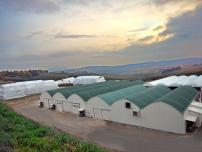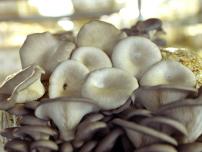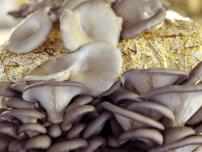Production stages

Production stages:
A. Selection and preparation of raw material
Firstly, every summer the selection and purchase of the main raw material takes place, which is the straw of durum wheat. The selection is done according to strict criteria because we seek the most eco-friendly approach.
After that on weekly basis we select a certain amount of straw for processing (chop 4-15cm, wetting over, and homogenization by turning the pile.)
B. Pasteurization
The already homogenized batch of straw, which from now on is called compost, enters the pasteurization tunnel.
The pasteurizing temperature varies depending on the variety of the pleurotus mushrooms we are going to cultivate. (64-70 Celsius degrees for 24-36 hours). After the process of pasteurization is over we cool the compost in ambient temperature and we are ready to start the spawn.
C. Incubation
For the next 15-20 days the blocks of pleurotus mushrooms are incubated in special designed chambers where the following conditions are maintained: temperature 22 Celsius degrees, pleurotus block temperature 22-28 Celsius degrees,75 % – 80% humidity co2 1000-1500 ppm, lighting 1-4 hours. The plerotus blocks that are going to be sent to other farms/mushroom cultivation units at the 15th -16th day are transferred to cooling chambers.
D. Production
The pleurotus blocks that are going to stay in our unit at the 20th day are transferred from the incubation chamber to the production chamber. Now the conditions are the following: temperature 17 Celsius degrees, pleurotus block temperature 19-20 Celsius degrees, relative moisture 85%-90% co2 max 750ppm, lighting 10 hours.
E. Harvest – Packaging
Under normal conditions the pleurotus block mushrooms will produce mushrooms ready for harvest 27 days after spawn. During the harvesting period (the duration of the harvesting period is 5-8 days) the lighting, the temperature and the humidity are adapted according to the quality that each production unit wishes to deliver to its customers.
The packaging must be conducted very carefully so that the mushroom cap stays intact. Usually, the bigger sized mushrooms are packaged in 3-kg crates and are intended for grilling. The smaller sized mushrooms are packaged in food trays of 400-500gr and are intended for cooking in the over or in the frying pan.
*(The conditions described above are indicative. Particularly, for the use of the strain “spoppo” of the Sylvan company)









